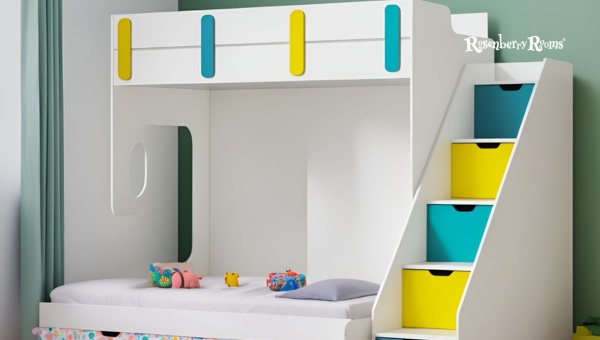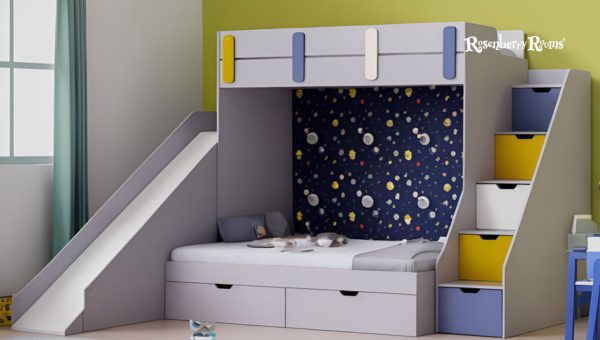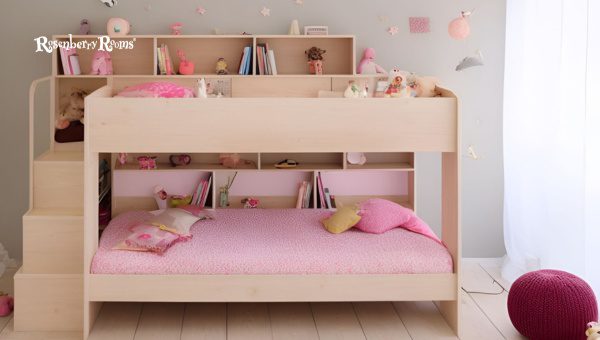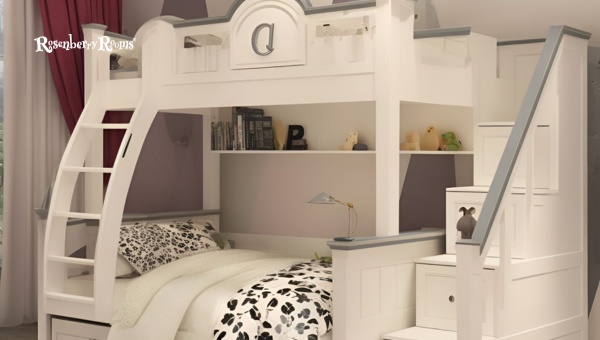Deciding the best age for bunk bed usage can be a bit of an enigma for many parents. You want to ensure your child is not only entirely safe but capable of enjoying this unique piece of furniture.
After all, getting a bunk bed isn’t just about saving space – it’s also about giving your kids something fun and adventurous they can call their own!
But safety is paramount, right? So, it’s important to establish appropriate boundaries regarding the age-appropriate use of bunk beds.
In this blog post, we will walk you through everything you need to know to decide when your little one is ready to climb up that ladder and into their exciting new sleeping quarters!
Contents

The best age for bunk beds usually starts from 6 years to 16 years old. This age range is considered safe because, by the time children are 6, they typically have developed enough agility and physical coordination to safely climb up and down a bunk bed ladder and have the maturity to understand safety rules.
From their teenage years to about 16, their interest in bunk beds might start dwindling due to their growing needs for individuality and privacy. However, each child is unique, and parental discretion is highly advised.

The standard height for bunk beds is usually between 5 1/2 and 6 feet tall. This height ensures that even relatively tall people can sit comfortably in the lower bunk without their heads touching the bottom of the upper bunk.
It also leaves ample headspace between the upper bunk and the ceiling, preventing head injuries to those on the top bed.
However, in homes with standard ceiling heights of 8 feet, it’s crucial to ensure there is enough gap left between the top bunk mattress and the roof to avoid any discomfort or risk. It’s also wise to leave some good clearance above the ladder for easy and safe access to the top bunk.
Read More: Floyd Bed Review [Upgrade Your Sleep Experience Today]

The best weight limit for bunk beds varies depending on the type of bunk bed and who is using it.
For kids’ twin bunk beds, the weight limit often falls between 150 to 220 pounds per bunk. This means that each bed can support this much weight without any risk of collapsing or causing harm to the child. These weights are generally suitable for children and teenagers.
Adult bunk beds’ weight limit ranges from 250 to 800 pounds. Adult bunks are typically more robustly built to accommodate a heavier weight load and thus can comfortably and safely support a grown adult.
Metal bunk beds are particularly durable and typically sustain a higher weight limit. They’re often chosen for their toughness, reliability, and sleek, modern appearance.
Investing in a bunk bed has several advantages that can significantly improve your child’s living space. Let’s dive into some key benefits:
Choosing functional furniture like a bunk bed enriches your children’s shared experiences and enhances their living space!
Knowing these crucial factors can guide you toward making the best decision before you rush into buying a bunk bed for your little adventurers.
These aspects cover everything from capacity and safety to design and future usage, so you’re fully prepared before jumping in. So, let’s bring those points into focus right away.
First things first: How much weight can the bunk bed hold? The weight capacity of a bunk bed is pivotal in terms of safety and longevity. The top bunk embraces less weight than the bottom one.
Most commonly, top bunks can hold up to 220 pounds for kids, and bottom bunks approximately twice that amount.
Confirm this crucial fact directly from the manufacturer before purchase. After all, ensuring your child’s safety is non-negotiable!
Not all bunk beds are created equal – especially regarding safety standards! To safeguard your children’s well-being, always check for valid certifications that guarantee adherence to safety standards.
A stamp of approval from bodies like ASTM International or the Consumer Product Safety Commission (CPSC) should be on any safe and reliable bunk bed.
These certifications affirm that the product has been thoroughly tested and its construction meets or exceeds necessary safety protocols.
The ladder to the top bunk is significant in safety, so don’t overlook it when choosing your bed. Make sure the ladder is sturdy and secure and designed for easy climbing. If possible, choose a bunk bed with a slanted ladder over a straight-up one for accessibility and safety.
The position of the ladder also matters. Right hand or left? This depends on the room’s layout and where you will place the bunk bed.
Before buying that perfect-looking bunk bed, please take note of the mattress thickness it can accommodate. Most safety rules suggest that the top guardrail must be 5 inches higher than the mattress top.
If the guard rail is too low compared to your mattress thickness, it might not provide adequate protection against falls. Always ensure that your chosen bunk bed and mattress complement each other regarding safety and comfort.
Investing in a convertible bunk bed now can offer flexibility for the future. Convertible bunk beds can generally be transformed into two separate beds. This becomes highly useful as your kids grow older and want their own spaces.
Or perhaps you may move to a house with more bedrooms in the future – a convertible bunk bed will prove an adaptable, cost-effective solution.
Explore More: Thuma Bed Review [60 Days: Is This Budget Beauty Worth?]

While understanding when your child is ready for a bunk bed and learning about essential features are crucial, knowing some of the safest bunk beds for children can make your purchase decision even more accessible. We’ve compiled a list of popular, secure, and certified bunk beds to help you out:
Also Read: 19 Best Places To Buy Kids Furniture Online In 2024 [Trustworthy Stores]
Whether you prioritize metal or wooden frame construction, all these options serve as stellar examples of quality and safety.
Each model adheres to rigorous safety standards, offers a child-friendly design, and ensures longevity. Regardless of what bunk bed you choose from this list – remember safety is paramount in any purchase decision.
After all, your child will enjoy their adventure-filled dreams much better with the peace of mind offered by their safe surroundings!
Most experts agree that your child should be at least six years old before using the upper bunk of a bunk bed.
While appealing in design, bunk beds are not recommended for children under six due to safety concerns, such as falls.
Ensuring the product meets safety certifications, checking weight limits, and properly using guardrails can considerably enhance your child’s safety.
Yes, as long as they adhere to the weight restrictions of the bed and provide adequate head clearance for top bunks.
While most kids find them fun and exciting, some may feel uncomfortable with heights or confined spaces – so always consider your child’s preferences.
So, as you can see, deciding the best age for a bunk bed involves thoughtful consideration. You should weigh each child’s maturity and the safety aspect of the bed itself and confirm that your chosen model meets all vital safety standards.
While bunk beds are indeed fun and can foster a spirit of camaraderie among siblings, it’s essential to maintain an unwavering focus on your children’s safety while sharing this adventure with them! Remember these factors and rest easy knowing you’ve made an informed and secure choice for your little ones.